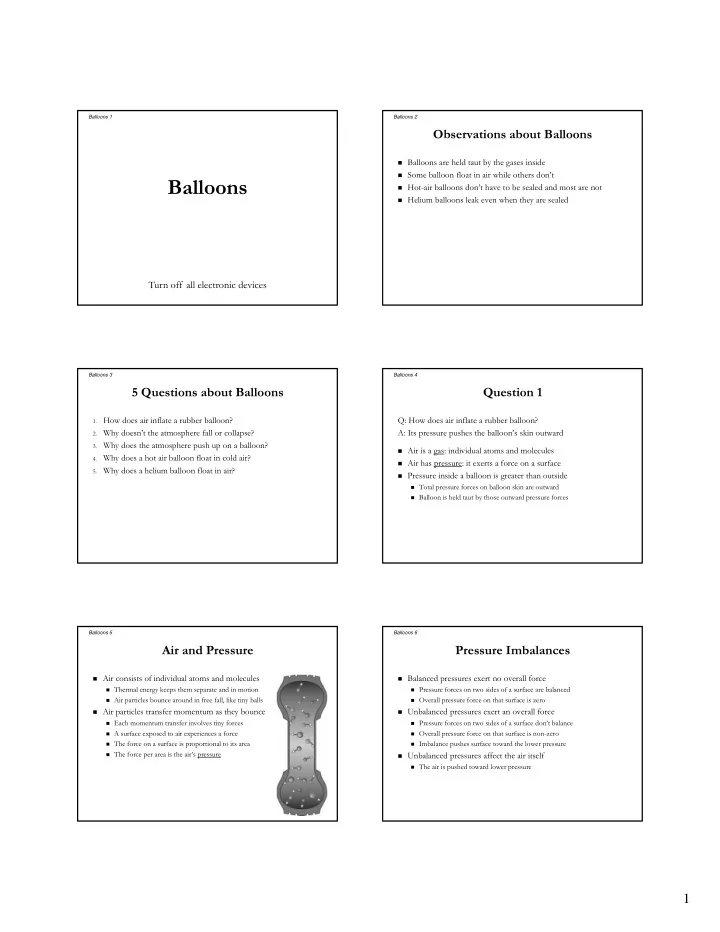

Balloons 1 Balloons 2 Observations about Balloons Balloons are held taut by the gases inside Some balloon float in air while others don’t Balloons Hot-air balloons don’t have to be sealed and most are not Helium balloons leak even when they are sealed Turn off all electronic devices Balloons 3 Balloons 4 5 Questions about Balloons Question 1 1. How does air inflate a rubber balloon? Q: How does air inflate a rubber balloon? 2. Why doesn’t the atmosphere fall or collapse? A: Its pressure pushes the balloon’s skin outward 3. Why does the atmosphere push up on a balloon? Air is a gas: individual atoms and molecules 4. Why does a hot air balloon float in cold air? Air has pressure: it exerts a force on a surface 5. Why does a helium balloon float in air? Pressure inside a balloon is greater than outside Total pressure forces on balloon skin are outward Balloon is held taut by those outward pressure forces Balloons 5 Balloons 6 Air and Pressure Pressure Imbalances Air consists of individual atoms and molecules Balanced pressures exert no overall force Thermal energy keeps them separate and in motion Pressure forces on two sides of a surface are balanced Air particles bounce around in free fall, like tiny balls Overall pressure force on that surface is zero Air particles transfer momentum as they bounce Unbalanced pressures exert an overall force Each momentum transfer involves tiny forces Pressure forces on two sides of a surface don’t balance A surface exposed to air experiences a force Overall pressure force on that surface is non-zero The force on a surface is proportional to its area Imbalance pushes surface toward the lower pressure The force per area is the air’s pressure Unbalanced pressures affect the air itself The air is pushed toward lower pressure 1
Balloons 7 Balloons 8 Question 2 Air and Density Q: Why doesn’t the atmosphere fall or collapse? Squeezing air particles more closely together A: A gradient in its pressure supports its weight increases the air’s density: its mass per volume increases the air’s pressure: its force per area Air has a density: it has mass per volume increases the air’s weight per volume Air’s pressure is proportional to its density Air’s density gives it a weight per volume The atmosphere is in equilibrium Its density and pressure decrease with altitude The resulting pressure imbalances support its weight Balloons 9 Balloons 10 The Atmosphere Question 3 Supporting its weight structures the atmosphere Q: Why does the atmosphere push up on a balloon? A pressure imbalance supports each layer’s weight A: Its pressure gradient pushes the balloon upward Air pressure decreases with altitude, a pressure gradient Because of atmospheric structure, air pressure is Each layer supports all of the air above it stronger near the bottom of a balloon, Net force on each layer is zero The atmosphere is in stable equilibrium weaker near the top of the balloon, so the air pushes up harder than it pushes down, and this imbalance yields an upward buoyant force The atmosphere pushes upward on the balloon! Balloons 11 Balloons 12 Archimedes’ Principle Question 4 A balloon immersed in a fluid experience an upward buoyant force Q: Why does a hot air balloon float in cold air? equal to the weight of the fluid it displaces A: It weighs less than the air it displaces As the temperature of air increases, its particles move faster, bounce harder, and bounce more often contribute more to air’s pressure A balloon filled with hot air at ordinary pressure contains fewer particles than the air it displaces weighs less than the air it displaces experiences a buoyant force that exceeds its weight 2
Balloons 13 Balloons 14 An Aside About Temperature Question 5 Air’s temperature on a conventional scale is Q: Why does a helium balloon float in air? related to average thermal kinetic energy per particle A: It weighs less than the air it displaces Air’s temperature on an absolute scale is Compared with air, the particles in helium gas proportional to average thermal kinetic energy per part. are lighter, but move faster and bounce more often SI unit of absolute temperature: kelvins or K contribute just as much to pressure 0 K is absolute zero: no thermal energy available A balloon filled with helium at ordinary pressure Step size: 1 K step same as 1 °C step contains as many particles as the air it displaces Room temperature is approximately 300 K weighs less than the air it displaces experiences a buoyant force that exceeds its weight Balloons 15 Balloons 16 Pressure and Particle Density The Ideal Gas Law Particle density: particles per volume is a summary relationship for gases: Particles in a gas contribute equally to pressure lower-mass particles move faster and bounce more, so all the effects of particle mass cancel out It assumes perfectly independent particles Gases with equal particle densities and equal temperatures have While real gas particles aren’t perfectly independent, this law is a good equal pressures approximation for real gases. Balloons 17 Summary about Balloons A balloon will float if its average density is less than that of the surrounding air A hot-air balloon has a lower particle density and a lower density than the surrounding air A helium balloon has the same particle density but a lower density than the surrounding air 3
Recommend
More recommend